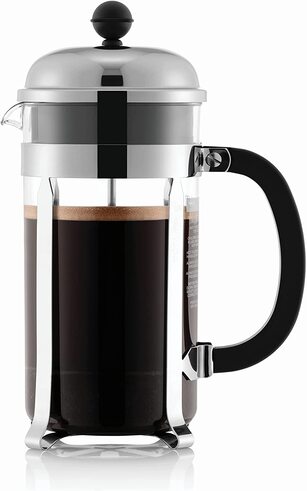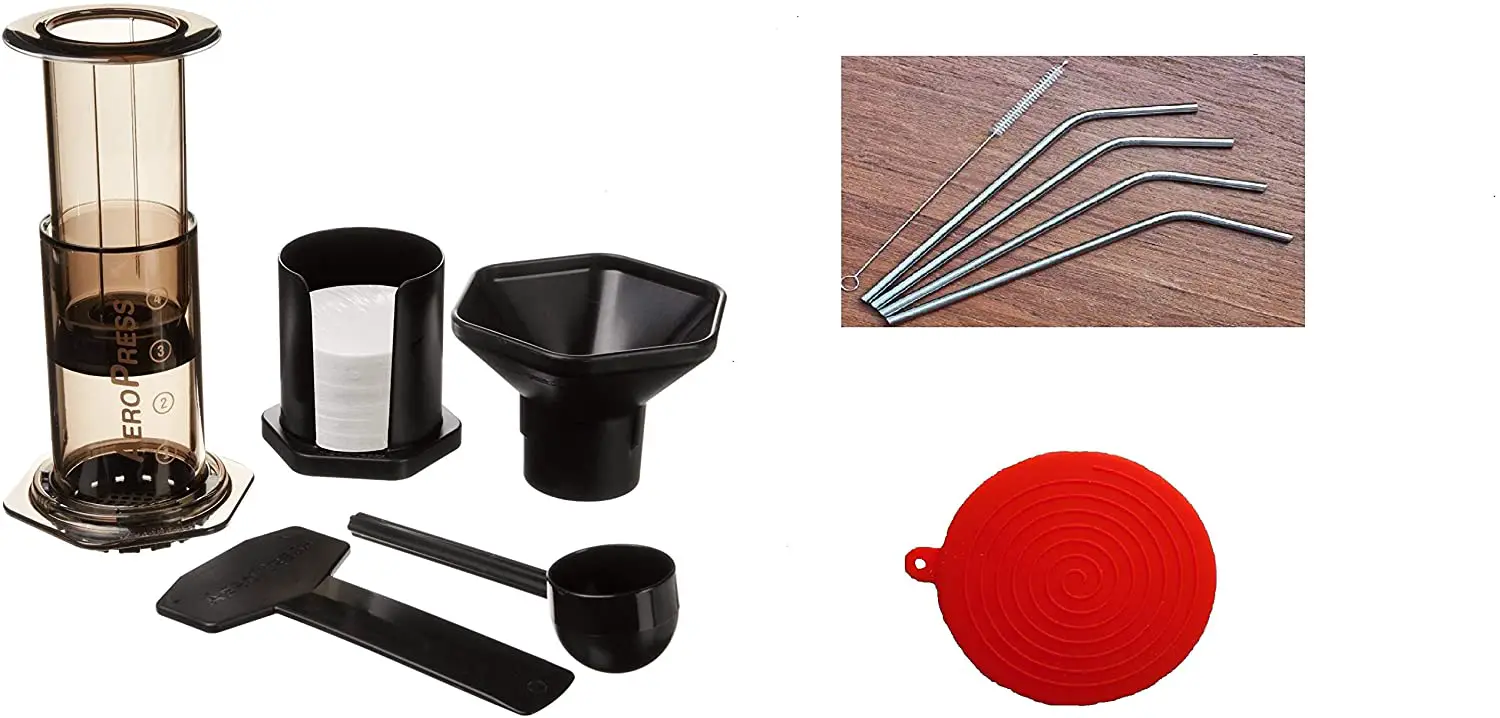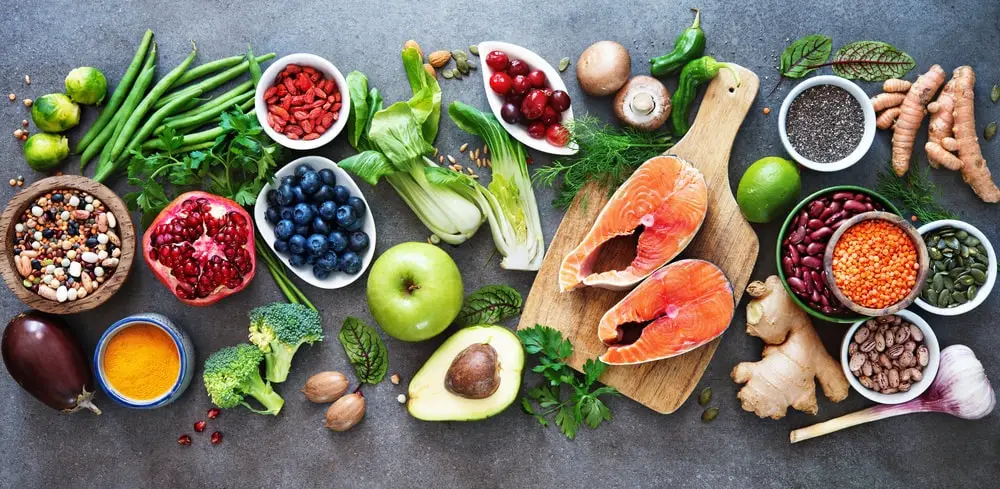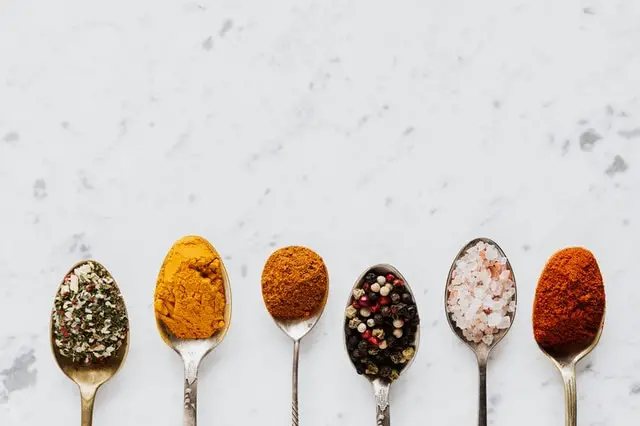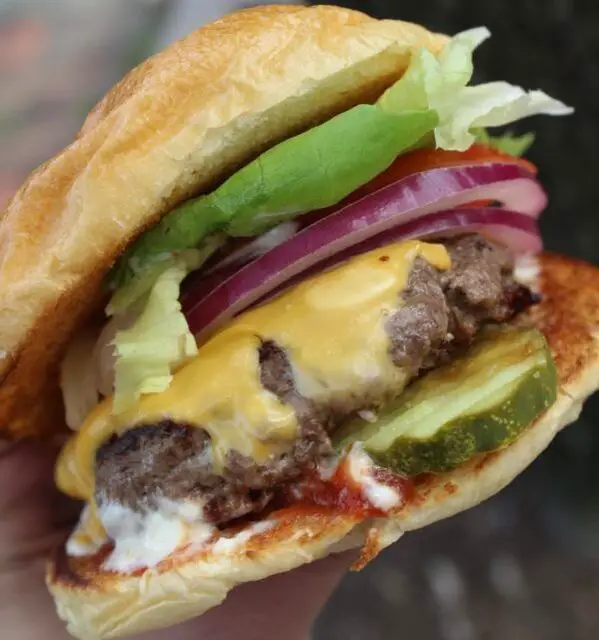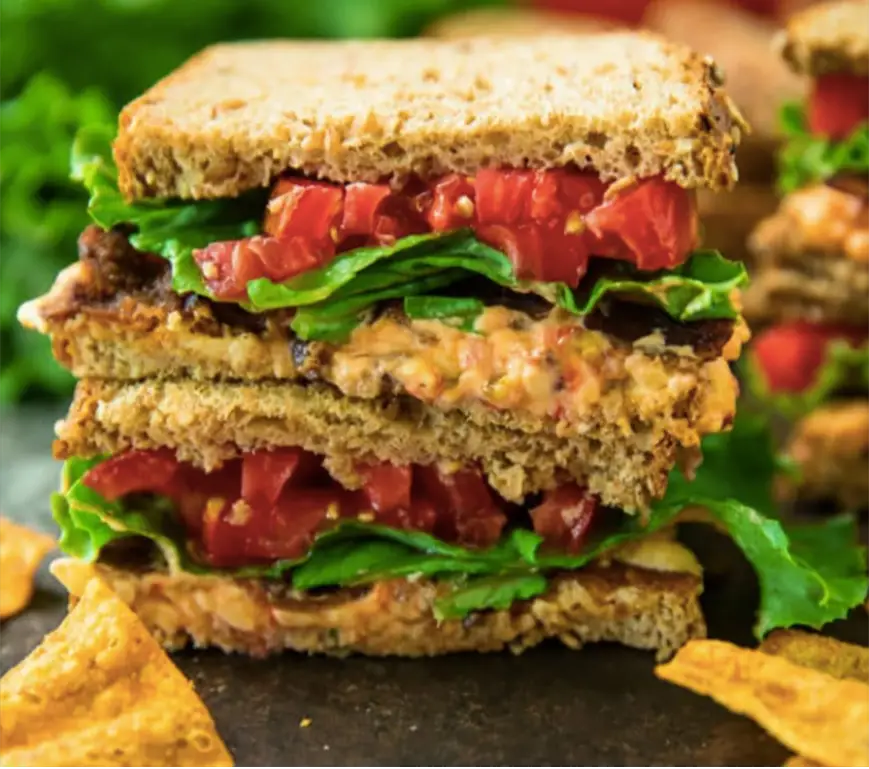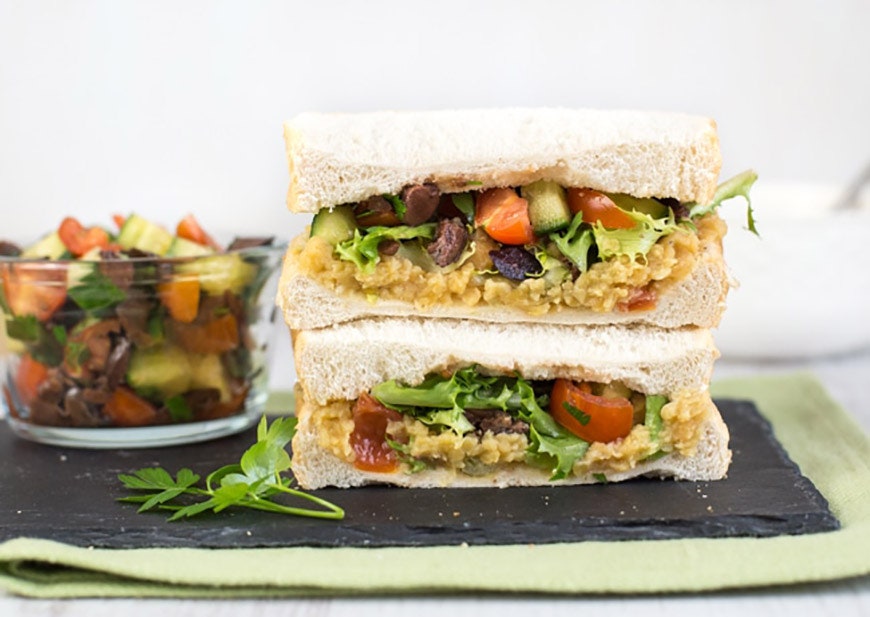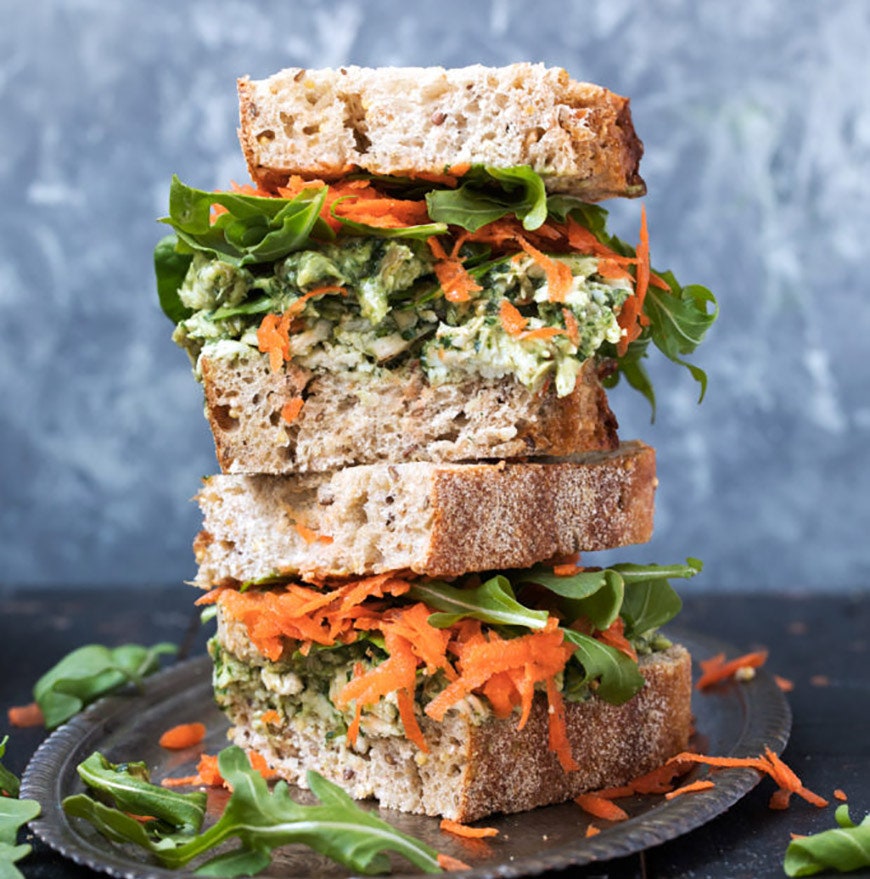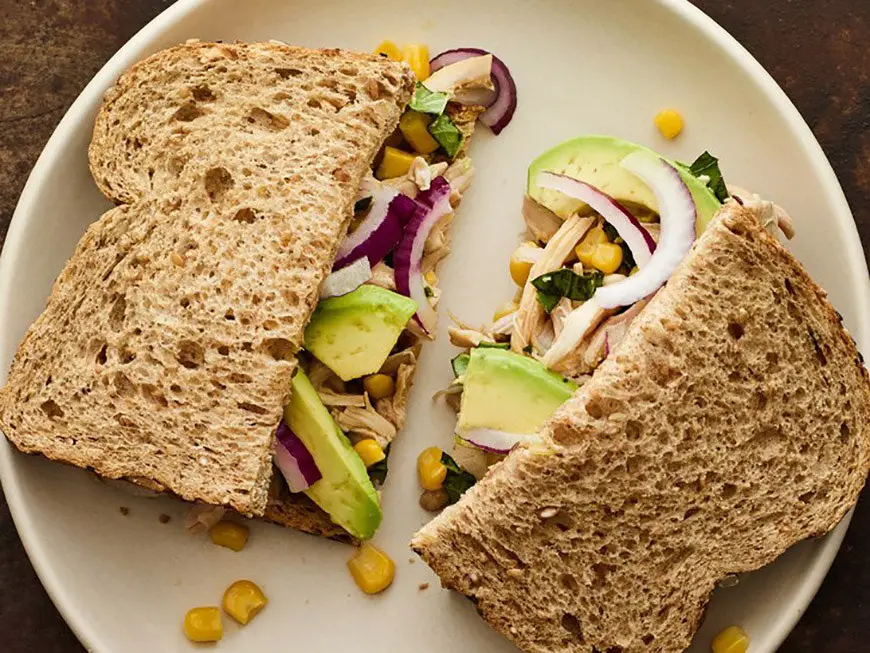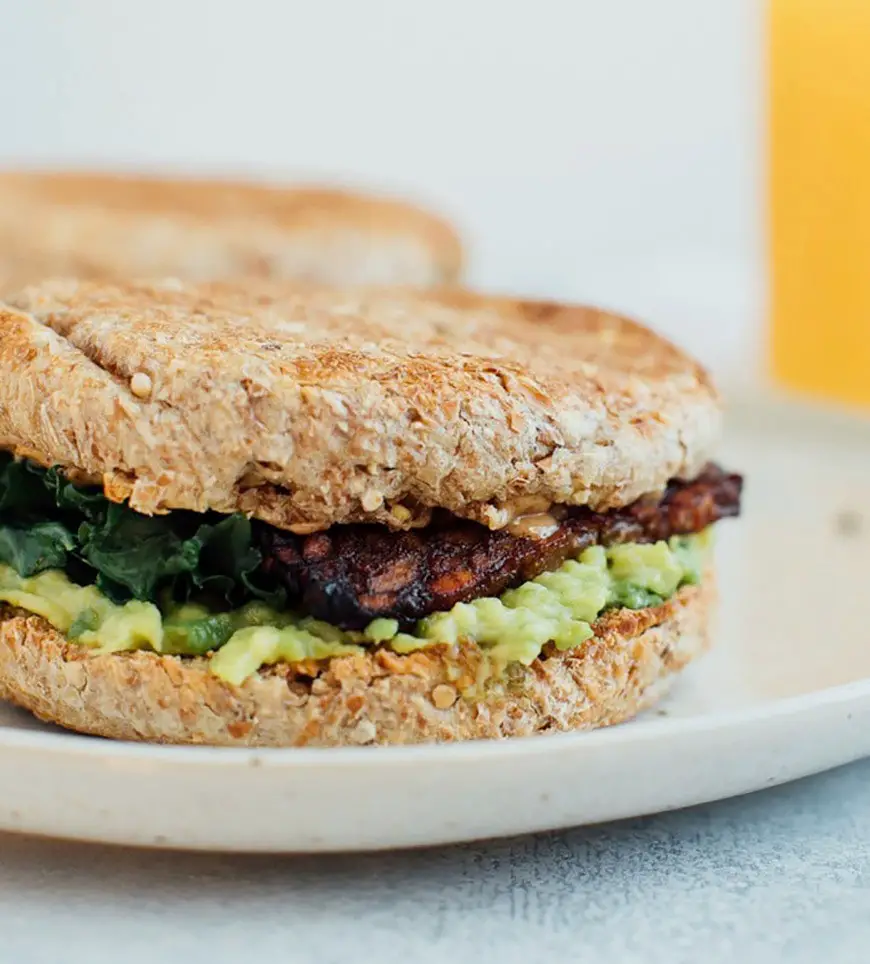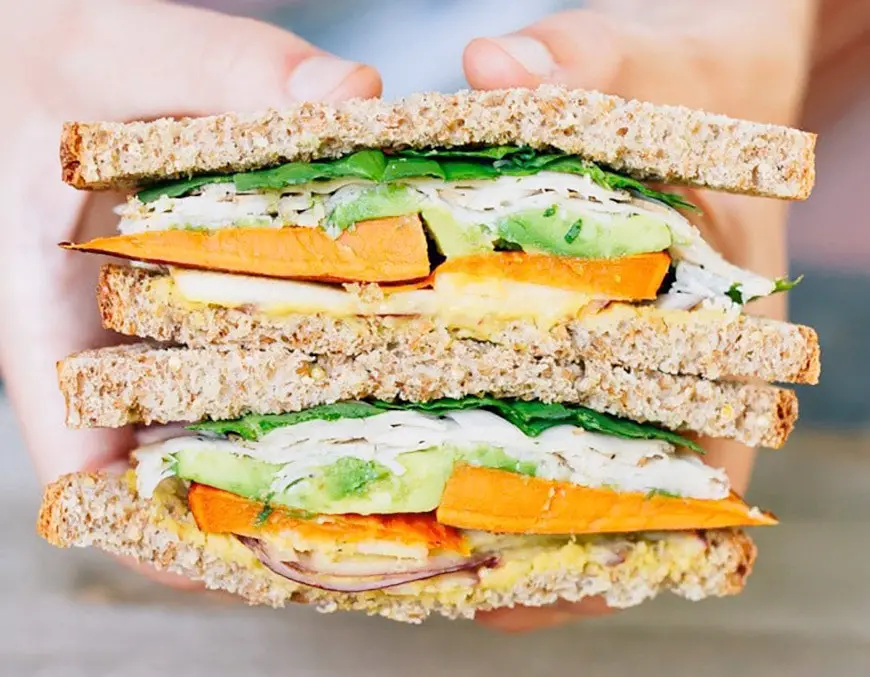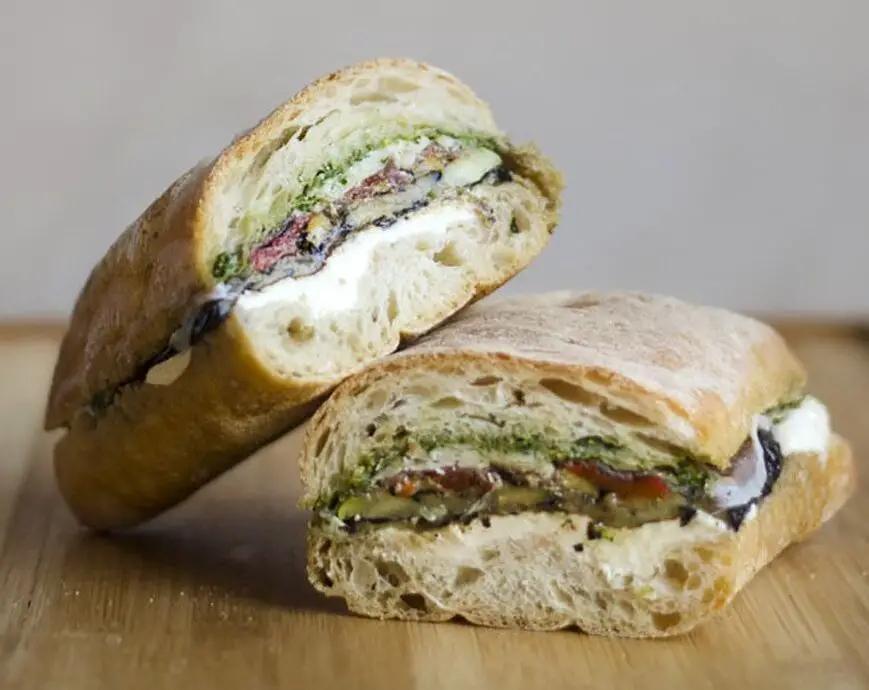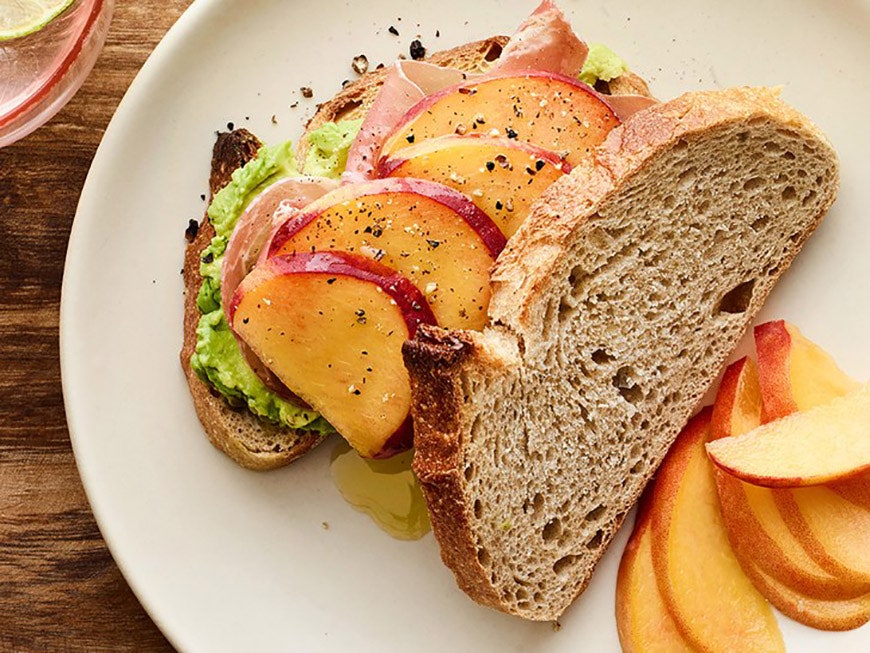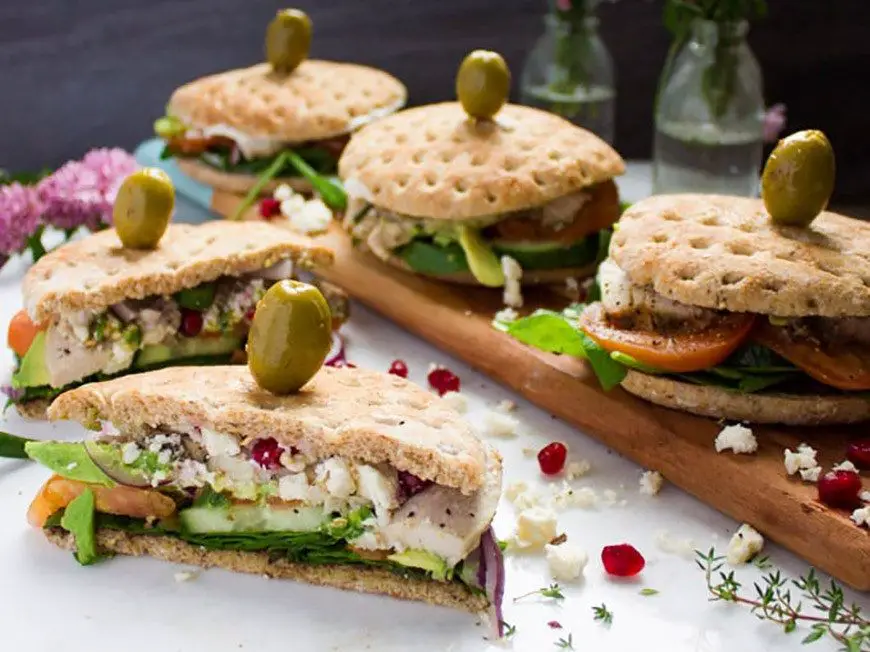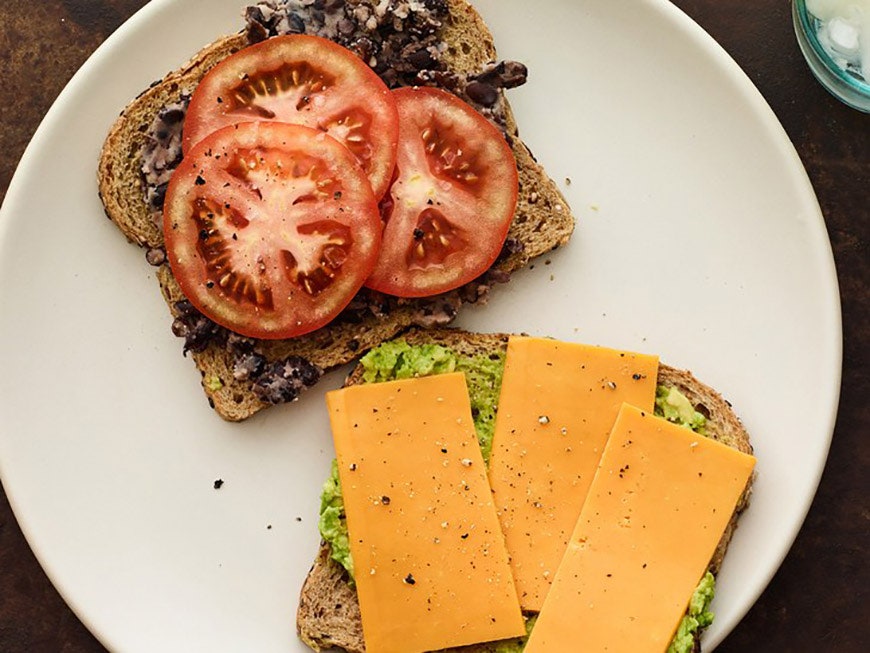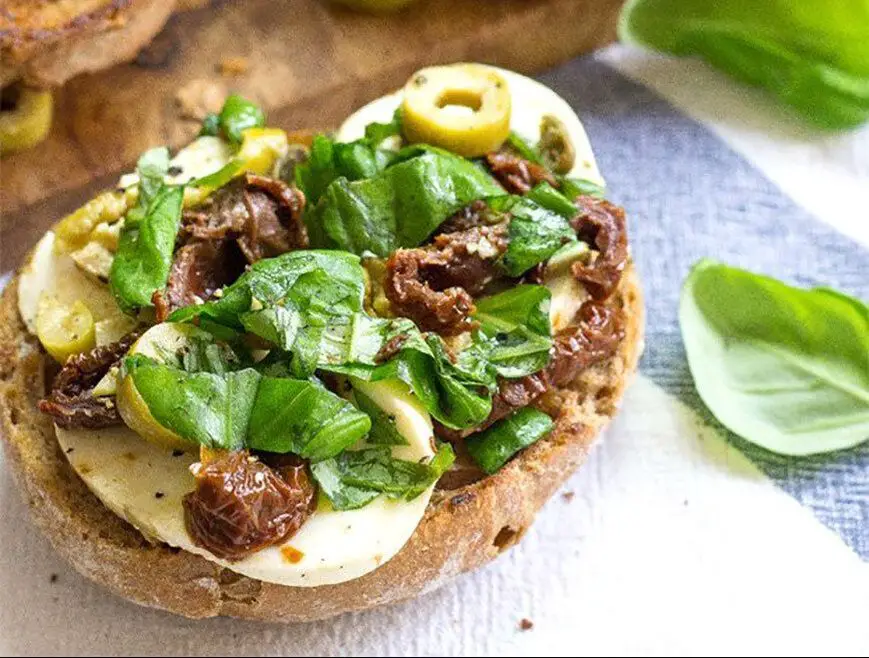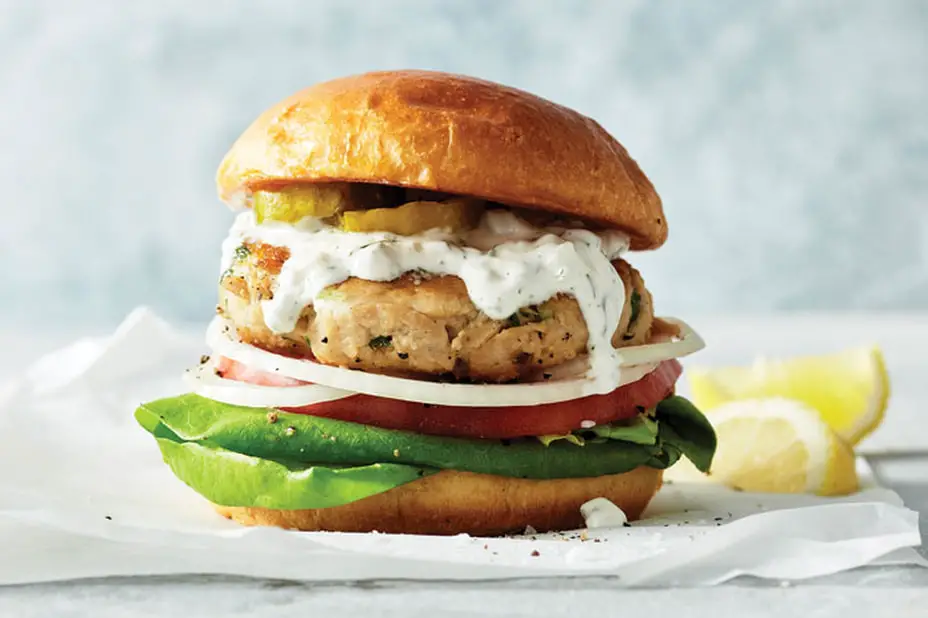|
Ever have one of those days when your entire body hurts, your skin breaks out, and your feel extremely tired? My answer is: that’s because you are eating the wrong food. In my experience as a nutritionist, every day I meet people who are stressed, tired and feel ill without any particular reason. In most cases, people have a problem with the foods they consume and not with some illness. So, in this article, we are suggesting you some of the healthiest foods that are essential for your well-being. Plus, we are providing a long list of substitutes, so even the pickiest eaters could get better right now.
1. Spinach This beautiful green and leafy vegetable is truly beneficial for our health. Spinach is a rich source of folate and plant-based omega-3s, which help reduce the risk of stroke, osteoporosis, and heart disease. This muscle builder is packed with lutein, a strong compound that combats macular degeneration . Opt for a ½ cup of cooked spinach or a cup of fresh spinach per day. A spinach smoothie can be an ideal choice, as well. Alternatives: bok choy, kale, romaine lettuce. Get your dose: Add spinach to scrambled eggs, make salads with spinach; place it over pizza; combine it with marinara sauce, add it to your favorite green smoothies. Switch this up: Kale is a great choice if you don’t like spinach. Casseroled kale is a tasty meal choice: heat 1 tablespoon sesame oil, add 3 cloves minced garlic, and 1 tbsp. minced fresh ginger. Add 1 bunch kale (chopped) and 2 tablespoons water Cover and cook for about 3-5 minutes. Then, drain. Add 1 tablespoon sesame seeds and 1 tablespoon soy sauce 2. Black Beans Although all sorts of beans are great for the health, still, no one can boost your brain power as black beans. That is because these beans are rich in powerful antioxidant compounds, called anthocyanins, which have been proven to improve the brain function . Just ½ cup of black beans per day provides about 7.5 grams of fiber and 8 grams of protein. These beans are also free of saturated fat and very low in calories. Alternatives: Lentils, pinto, and peas, fava, lima and kidney beans Get your dose: You can wrap some black beans in a burrito for breakfast; use both kidney and black beans in your chili; add lima, peas, or favas to pasta dishes; mash 1 cup black beans with some roasted garlic and olive oil for a healthy dip. Switch this up: Tomato salsa and black bean. Chop 4 tomatoes, 2 jalapeños, 3 cloves garlic, 1 onion, 1 mango, and 1 yellow bell pepper. Mix in a container of black beans and decorate with some cup chopped cilantro and add the juice of 2 limes. 3. Blueberries Blueberries contain more antioxidants than any other fruit that comes from North America. They can help Many studies show that these berries, which are rich in vitamin A, vitamin C, and fiber, also improve cardiovascular health . Opt for one cup of fresh blueberries per day, or ½ cup dried or frozen. The easiest way to get all of their nutrients is by starting your day with a refreshing blueberry smoothie! Alternatives: Purple grapes, strawberries, acai berries, raisins, and prunes Get your dose: These berries maintain most of their power in a jam, frozen, or dried form. Switch this up: An Amazonia berry, called Acai berry, contains even more antioxidants than the blueberry, or you can try blackberries. 4. Oats Oats are packed with soluble fiber that lowers the risk of cardiovascular disease . Well, oats are also loaded with carbs, but the release of these sugars is decelerated by the fiber. Due to their incredible 10 grams of protein just per ½ cup portion, oats can deliver great energy. Alternatives: wild rice, flaxseed, and quinoa Get your dose: Eat cereals and granolas that have a fiber content of at least 6 grams per serving. You can sprinkle 3 tablespoons ground flaxseed on salads, yogurt, and cereals. Switch this up: Prepare a quinoa salad, which has 2 times more protein than most cereals, and lesser carbs. Add 1 cup of quinoa into 2 cups of water and place on the heat. Boil for 2 minutes. Let cool. Toss it with 2 diced apples, 1/2 cup chopped walnuts, 1 cup plain fat-free yogurt, and 1 cup fresh blueberries into a large bowl. 5. Tomatoes Fresh tomatoes from the garden are definitely the best. However, you should know 2 things: the red ones are packed with more of lycopene, the potent antioxidant, and processed tomatoes are just as powerful as fresh ones because it is easier for your body to absorb this antioxidant. Studies found that a diet rich in lycopene can reduce the risk of lung, skin, bladder, stomach, and prostate, cancers, as well as decrease the risk of coronary artery disease . Opt for 22 mg of lycopene per day, which is around 8 red cherry tomatoes or 1 cup of fresh tomato juice. Alternatives: Pink grapefruit, red watermelon, guava, papaya, Japanese persimmon. Get your dose: use homemade tomato sauce on your pasta, pizza, gazpacho and many other recipes. Switch this up: pink and red fruit bowl. Simply chop 2 grapefruits, 1 papaya, and 1 piece of watermelon. Garnish with a few mint leaves. Or you can try watermelon, walnut, and mint salad. 6. Walnuts Walnuts are loaded with more polyphenols (great antiinflammatories) than red wine and richer in omega-3 fatty acids than salmon . These magnificent nuts are also packed with muscle-building proteins . A portion of walnuts—about 1 ounce, or 7 nuts—is great anytime. Alternatives: macadamia nuts, hazelnuts, almonds, pistachios, and peanuts. Get your dose: Add walnuts to vegetable and fruits salads, or to pancake batter; grind and mix some with olive oil to prepare a marinade for grilled chicken or fish. Switch this up: You can mix 1/2 cup dried blueberries with 1/4 cup dark chocolate chunks, and 1 cup walnuts. 7. Yogurt Fermentation spawns’ numerous probiotic organisms, which serve as reinforcements to the throngs of beneficial bacteria in our bodies. That helps improve your immune system and aids provide protection against many types of cancer . Remember, not all yogurts are probiotic, however, so when you buy one ensure the label states “live and active cultures”, or try to make your own natural yogurt (you can find what you need from people who raise goats, cows, or ships). Opt for 1 cup of the protein and calcium-rich goop per day. Alternatives: Soy yogurt, kefir Get your dose: Blueberries fruit yogurt (check out how to make a delicious homemade blackberries fruit yogurt or breakfast or as a dessert. Plain low-fat yogurt is also an ideal base for creamy salad dressings. Switch this up: Energetic smoothie: put in a blender 1 cup low-fat yogurt, 1 cup carrot juice, 1 cup fresh baby spinach, and 1 cup fresh or frozen blueberries for a nutrient-rich blast. Conclusion: Healthy foods help prevent certain health diseases, such as stroke, high blood pressure, and heart disease. If you take care of yourself and your family, you can keep your health within a safe range. People who follow a healthy, well-balanced diet decrease their risks of chronic diseases, such as cardiovascular disease, cancer, and diabetes. Aim to eat the above-stated foods as much as possible, and follow a diet rich in unsaturated fats, fruits, vegetables, and whole grains. This article first appeared on Your Health Tube. This article is intended to be general information use and is not intended to constitute medical advice, probable diagnosis or recommendation treatments. After a strong year in 2020 during the pre-vaccine stage of the COVID-19 pandemic, CPG pizza sales dipped somewhat in 2021, although they remained well above pre-pandemic levels, according to market research firms. Frozen pizza brands—whose sales account for 14% of the total pizza market, according to Technomic—are working to maintain momentum by providing restaurant-quality products and delivering healthier formulations without ignoring consumers’ desire for convenient comfort food. Frozen pizza sales shot up by 20.4% to nearly $6.0 billion for the 52 weeks ending Dec. 5, 2020, but sales fell 3.6% to about $5.8 billion for the 52 weeks ending Dec. 4, 2021, according to NielsenIQ. Multi-serve pizza sales comprised the bulk of the category, at $4.7 billion, down 4.2% in the latter time frame, while single-serve SKUs saw just over $1 billion in sales, down 0.2%. Center-store pizza-related sales, which are considerably smaller than those of frozen, also saw a small drop-off in 2021 after a major increase in the earlier phase of the pandemic. Total center-store sales of pizza products rose 38.1% to $173.4 million for the 52 weeks ending Dec. 5, 2020, then dropped 6.2% to $162.6 million for the 52 weeks ending Dec. 4, 2021, NielsenIQ figures show. Crusts comprise the bulk of that category, at $142.6 million, down 5.2% for the more recent 52 weeks. Two years into the pandemic, consumers who are working remotely, navigating economic uncertainty, and experiencing cooking fatigue will continue to rely on convenient, affordable meal solutions, according to Kaitlin Kamp, food and drink analyst for market research firm Mintel. “Still, future growth [for the pizza category] is somewhat stifled as consumers renew their health aspirations and return to pre-pandemic routines, leading to slow and modest growth through 2026,” she says. “Brands will find growth opportunities in remote workers, homemade pizza, and improved quality that rivals foodservice operators,” Kamp predicts. Baking in Health Appeal Mintel research found that nearly two-thirds (65%) of those who live in households that eat pizza wish it were healthier, most often citing all-natural ingredients (44%), extra vegetables (41%), low fat (30%), low carb (29%), high protein (27%), and organic (25%) as attributes that would further the health halo. Globally, “vegetarian” was the most frequent positioning for new pizza launches between April 2020 and September 2021, featured on 14% of such SKUs, according to data from Innova Market Insights. Less often seen are callouts such as no additives/preservatives (11%), gluten-free (10%), traditional (7%), and high source of protein (7%). In contrast, gluten-free positioning (34%) topped the list for U.S. launches during that period, followed by high source of protein (24%), no additives/preservatives (22%), GMO-free (15%), and traditional (14%). "The desire for satisfying, restaurant-quality pizza at home continued throughout 2021, and we expect it to continue into 2022 and beyond." - Brian Schiegg, President , Schwan’s Consumer Brands During the first year of COVID, consumers were leaning into more indulgent and cheaper comfort foods like “mac-and-cheese and pepperoni-laden, $3.99 pizzas—belly fillers,” says cauliflower crust pizza pioneer Gail Becker, founder and CEO of Caulipower. “In 2021, people realized, ‘Hey, I have to wear jeans again,’” she continues. “They noted the ‘COVID 15’ and are now choosing much healthier options. … That has served Caulipower very well.” The company has worked assiduously to stay on top of sourcing the right ingredients, with an eye toward beating the supply-chain snarls, Becker says. “People are definitely more cognizant of what they’re eating,” she says. “They want cleaner labels and more transparent, healthier options. The year of eating whatever you want to make you feel better is over. Now, people want to feel good about what they’re eating. It’s not as much food as comfort, as it is food as nourishment.”  Cappello’s Naked Pizza Crust gives home cooks an easy head start on do-it-yourself creations. Photo courtesy of Cappello’s Cappello’s Naked Pizza Crust gives home cooks an easy head start on do-it-yourself creations. Photo courtesy of Cappello’s The Cappello’s pizza brand has amped up its health orientation in the past year, launching low-carb and no-sugar-added, keto-certified pizzas with crusts made from turnips and almonds. The line includes Buffalo ranch, cheese, and a crust-only SKU, says company president Rajesh Babu, who came on board in 2021. “There’s this increased emphasis on pantry-loading,” he says. “People are looking for nutritious, healthy foods that can last a bit. … The pandemic became the world’s largest trial-driver. If you’re on the shelf, people are going to try you. We had a nice jump during the pandemic. The nice thing is, we’ve sustained that lift.” As cauliflower has become more ubiquitous as a crust base, brands are trying other formulations to catch the eye of health-oriented consumers, as well as using plant-based cheese and meat substitutes, and higher-quality toppings like uncured meats, Babu says.  Schwan’s touts the “kitchen fresh” appeal of its Freschetta pizza. Photo courtesy of Schwan’s Consumer Brands Schwan’s touts the “kitchen fresh” appeal of its Freschetta pizza. Photo courtesy of Schwan’s Consumer Brands Schwan’s has noted a surge in protein and plant-based innovation and claims, given consumers’ desire to eat healthier foods that they still enjoy, says Brian Schiegg, president of Schwan’s Consumer Brands, which includes Red Baron, Tony’s, and Freschetta in its stable of pizza brands. “Protein, in particular, is viewed as a healthy way to fill up families and keep them full longer,” says Schiegg. “These may result in innovations using alternative food ingredients, or simple renovation of existing items, or packaging callouts. However, it is imperative that these new product attributes do not sacrifice taste.” Keeping the Quality High The loss of access to favorite restaurants didn’t cause consumers to lose their taste for foodservice-quality pizza, Schiegg emphasizes. “In fact, the desire for satisfying, restaurant-quality pizza at home continued throughout 2021, and we expect it to continue into 2022 and beyond,” he says. “The perceptions of frozen food products as ‘less than fresh’ have started to erode, with more consumers recognizing the benefits of the frozen category, including price point, shelf life, nutrition, and convenience,” Schiegg notes. “We know there’s room to grow retail’s piece of the pie. 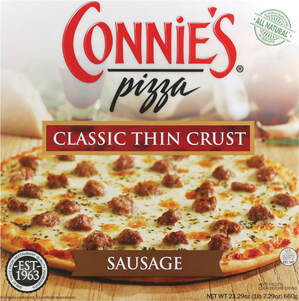 Connie’s Frozen Pizza appeals to Midwestern fans of the Connie’s pizzeria experience. Photo courtesy of Palermo Villa Connie’s Frozen Pizza appeals to Midwestern fans of the Connie’s pizzeria experience. Photo courtesy of Palermo Villa “We know that a reduction in out-of-home eating occasions and a desire for comfort food and indulgence during challenging times have added tailwinds to what was already a strong growth trend in the premium segment of frozen pizza,” he adds. “We also know that a large number of new consumers have been drawn to the frozen pizza aisle for the first time, or perhaps the first time in a while, seeking stress-free and family-pleasing options.” In a report on the retail pizza category released in October 2021, Mintel identified value as a key selling point, best demonstrated “by loading products with extra toppings and sides and upgrading product quality, with specialty flavors and premium ingredients.” Brands should expand product offerings and upgrade sauces, crusts, and toppings to rival those of foodservice, targeting the at-home lunch occasion with messaging that underscores convenience and “energizing ingredients,” the report suggests. The frozen pizza category has evolved to include an influx of “pizzeria” brands as consumers’ expectations for higher quality have been raised, says Nick Fallucca, chief production and innovation officer at Palermo Villa, a manufacturer of branded and private label pizza. “Many of these products are rooted in strong regional chains that are both popular and familiar,” he says. “For example, our Connie’s Frozen Pizza has experienced strong growth in the Midwest and has expanded to other markets where consumers are seeking the Chicago pizzeria experience.” 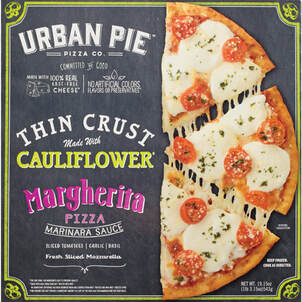 Urban Pie offers a line of thin crust pizzas with veggie crusts, including this Cauliflower Margherita variety. Photo courtesy of Palermo Villa Urban Pie offers a line of thin crust pizzas with veggie crusts, including this Cauliflower Margherita variety. Photo courtesy of Palermo Villa Palermo Villa added two new flavors in 2021 to its ‘Za Brewski line of pizza with beer-infused crust, which it developed in partnership with Jacob Leinenkugel Brewing Company. The company believes consumers are challenging frozen pizza brands to elevate their game to restaurant-style offerings, says Fallucca. “We think we’ve done this with our high-quality crusts, such as Artisan Stone Fired Butter Crust used on Screamin’ Sicilian, or our Artisan Thin Pastry Crust used on Urban Pie [pizzas],” he adds. Homemade Appeal
When Mintel asked consumers what type of retail pizzas they had eaten in the past three months, a small but growing segment cited “pizza I made myself” (32% in 2021, up from 29% in 2020). The percentage who said they prepared pizza at home from a kit had also increased to 16% in 2021 versus 13% in 2020. Mintel sees the potential for growth in the latter subcategory. “The kits and components segment makes up only 8.2% of category sales currently, leaving ample opportunity for expansion,” the report says. “Brands should explore premium foodservice-inspired crusts, sauces, and toppings, such as deep-dish dough or margherita pizza sauce; 65% of households that eat pizza are interested in premium ingredients to make their own pizza at home.” Product Development Priorities Innova Market Insights reports that new product development in the United States has tailed off considerably. Between the second quarter of 2019 and the second quarter of 2020, 119 new pizza products were introduced, but in the same time frame between 2020 and 2021, that total fell to just 70. For the period from April 2020 through September 2021, the top flavors for U.S. pizza launches were pepperoni (21%), mozzarella cheese (10%), margherita (9%), cheese (8%,) and cauliflower (7%), according to Innova. Caulipower unveiled a number of new products in 2021. “We used 2020 to innovate like crazy,” says CEO Becker. The company rolled out a Buffalo chicken SKU, larger versions of barbecued chicken and half-pepperoni/half-cheese offerings, and artisanal stone-fired products, as well as the brand’s first-ever packaging redesign. Schwan’s released two new offerings in October 2021: the Red Baron Stuffed Crust Pizza, in three flavors—Pepperoni, Four Cheese, and Meat Trio—and the Red Baron Fully Loaded Pizza, also in three flavors—Pepperoni, Five Cheese, and Supreme. This followed two releases in the summer of 2020: Red Baron Pizza Melts in Pepperoni, Supreme, and Four Cheese flavors, and Freschetta Thin Crust Pizza in Premium Pepperoni, Five Cheese, and Garden Veggie varieties. The brand will launch a Freschetta Margherita and Roasted Garlic SKU this year. Fallucca of Palermo Villa believes the trend toward frozen pizza featuring health-oriented claims has lost momentum. “Gluten-free is still popular in some channels but doesn’t have the same growth trajectory as before,” he says. Still, he thinks that plant-based SKUs are “here to stay.” His company’s Urban Pie line, which includes varieties like Sweet Potato BBQ Chicken, Broccoli & Cheddar Bianco, and Cauliflower Margherita, tout their veggie-based crusts. The editors at Food Technology magazine, published by the Institute of Food Technologists (IFT), have announced their predictions for the hottest food trends for 2022. The editors at Food Technology magazine, published by the Institute of Food Technologists (IFT), have announced their predictions for the hottest food trends for 2022. Here’s what they’re forecasting for the coming year:  Alt-Meat Consolidation The alt-proteins sector shows every sign of being ripe for robust M&A activity in 2022. It's a classic build-it-or-buy-it scenario, as upstarts in the plant-based and cellular market look to quickly fortify their first-mover advantage, while traditional giants invest to hedge against seemingly inevitable market shifts. The plant-based front-runners, including Impossible Foods and Beyond Meat, have been accumulating cash needed for bold moves. Meanwhile, traditional meat companies like Tyson and Cargill have spread investments across a field of cellular protein companies, including New Wave Foods, Memphis Meats Aleph Farms, and Future Meat Technologies. —Bill McDowell, Editor-in-Chief Discriminating Consumers Will Get Choosier A growing group of highly health-aware consumers, concerned about the impact of specific food groups (meat, dairy, sugar) on their well-being, will embrace dietary changes, creating more opportunities for the next generation of plant-based foods, lower-sugar offerings, and other healthy lifestyle products. The trend will be driven by aging boomers facing medical problems and nutritionally savvy millennials. —Mary Ellen Kuhn, Executive Editor Upcycling on the Upswing The concept of upcycling food waste has been around for years but expect it to become front and center for food manufacturers in the coming years. As higher commodity prices continue to stress bottom lines, companies are looking for new revenue streams from outputs that used to be considered waste. In October, Dole Sunshine Co. launched a new venture called Dole Specialty Ingredients to source and transform fruit side streams and unutilized fruit parts by repurposing them into high-value natural products like enzymes, extracts, seed oils, and fibers. More companies will follow suit. —Kelly Hensel, Senior Digital Editor  More Milk Alternatives Plant-based milks have continued to surge in popularity due to their health and nutritional benefits, clean label attributes, and eco-friendly profile. Look for an explosion of new launches in this highly competitive space, where oat-based products recently outpaced soy to take the No. 2 spot in sales. While pea-based products have also caught on with consumers, a slew of new formulations made from beans, chickpeas, barley, hemp, and flax will continue to reshape and expand the milk-alternative space. —Margaret Malochleb, Associate Editor. Smarter Era for Food Processing As we continue to talk about the "New Smarter Era for Food Safety" processors look for ways to transform their operations to be more digitally integrated. However, this also creates reservations due to the fears of data breaches, and lack of capacity to meet the workforce needs of the future. There will be a renewed interest in the smart use of sensors, data, and AI models with strong prediction capabilities as digital tools promise increased efficiency, safety, and sustainability in the food processing industry. —Ziynet Boz, Contributing Editor, Processing 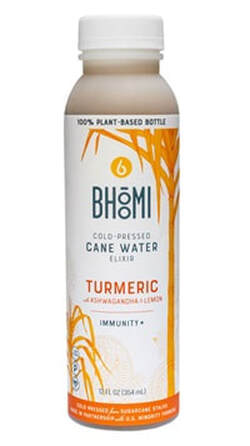 All is Calm Immune health will remain top of mind for consumers, but expect increased interest in products that promote calm, relaxation, and stress reduction. The past two years have been anything but stable and peaceful, so ingredients reported to help with anxiety and stress will be popular. Look for melatonin, L-theanine, magnesium, and botanicals such as lavender, ashwagandha, valerian, and chamomile. —Linda Milo Ohr, Contributing Editor, Nutraceuticals Relaxed Food Safety in Cottage Foods In 2021, there were 69 bills in 29 state legislative sessions that endeavored to relax or eliminate food safety requirements for retail sale of cottage foods; 14 were enacted into law. Arkansas and Montana, for example, now both exempt producers of homemade food and drinks from licensure, certification, and inspection. This kind of legislation puts the burden of food safety and inspection on the consumer. Food safety professionals should be proactive in educating consumers and providing data-based evidence to state legislators to help them make sound decisions as this trend continues in 2022 and beyond. —Jane Caldwell, Contributing Editor, Safety & Quality 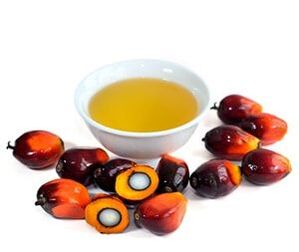 New Insights Into Diet and Cancer A study published in Nature in November found that when palmitic acid, a fatty acid commonly found in palm oil, was added to the diet of mice, mouth and skin cancers were more likely to spread. Oleic acid and linoleic acid did not demonstrate such effect. This discovery augments our understanding of how diet and cancer are linked. This revolutionary study will lead to more studies in 2022 on how dietary choices influence the risk of cancer progression, and more significantly, how this knowledge can be used to enhance existing cancer treatments and discover new treatments. —Gülhan Ünlü, Contributing Editor, Safety & Quality Moving Toward More Intelligent Packaging
Scientific advances and economic need will spur the development of consumer- and retailer-friendly intelligent packaging. The science includes big data; the link between shelf life and pH, hydrogen sulfide, and carbon dioxide for specific foods; and advances in reactive inks. The economic need includes consumers realizing that food waste is expensive and inconvenient as they are faced with higher food prices and fewer store trips, and retailers realizing they can ease logistical stresses if they reduce in-store waste. —Claire Koelsch Sand, Contributing Editor, Packaging A Stall on the Path to the ‘New Normal’ The food/beverage and restaurant industries’ long-awaited journey to a “new normal” has stalled and run smack into economic headwinds, supply chain/labor issues, and a new set of COVID-19 variants. Higher menu prices have caused a downturn in restaurant revenues adjusted for inflation. Online food shopping is fast approaching the pandemic high of 20%. COVID churns on and its influence will continue to skew traditional consumer behavior. However, true product innovation, greater personalized premiumization, restaurant/retail culinary wars, and an even more aggressive self-care movement will be among the emerging positive trends going forward. —Liz Sloan, Contributing Editor, Consumers This list is based on Yelp reviews and ratings at restaurants in the "vegetarian" category. State by State. The Meatless Monday trend has become a popular way to eat healthy during the week, but for many people vegetarian meals are a lifestyle. Whether you always stick to plant-based foods or just want to try something new, Greene Fusion was selected as one of the best vegetarian restaurants in New Jersey, according to Yelp. These spots use vegetables in insanely creative ways that go way beyond salads, and they're definitely worth a visit. "Excellent food whether you are vegan or not! I've dined at Green Fusion many times and it never disappoints! Kind staff, great food and clean restaurant. Highly recommend their dessert! I typically do not get dessert when out but I get it at Green Fusion every time! Also, food is just as good as take out." - Yelp user Jillian R.
You could have the best beans in the world, but the extraction process ultimately determines how your cup of coffee turns out. "Brewing coffee is a chemistry experiment: It comes down to using water as a solvent to extract compounds from coffee beans," says Makenzie Bryson Jackson, MS, food scientist and product development manager at Panaceutics. "And every extraction method brings out different notes in the coffee beans." The best coffee machines, she says, take the guesswork out of the process. But different machines yield different results. First, Jackson says to make sure you have clean quality water, fresh beans, and a good grinder. Then, focus on the three T's of the extraction process: "That's time, temperature, and turbulence," she says. "Time is how long the water is in contact with the coffee grounds—the longer it is, the more compounds will be extracted. Not enough time results in under-extraction: sour, weak, and watery. And going too long results in over-extraction: bitter, hollow, and burnt notes." As for the temperature, the optimal range of water temperature for extracting is between 195 and 205 degrees. And the last T—turbulence—happens as water flows over the ground coffee. "If you pour water too slowly, it could create tunnels and not all of the grounds may be uniformly wet," says Jackson. "When you make a coffee that's fully submerged before filtering, such as when using a French press, you want to stir it to ensure all of the bean particles are exposed to water." Jackson employs five different coffee brewing methods at home, each requiring a little more effort than the last. While some machines do most of the work for you, others will take a little more effort. But no matter which you prefer, there isn't a wrong way to enjoy your coffee. "Perfection is all in the tastebuds of the sipper," she says. "There are some machines like Nespresso and Keurig that try to take all of the guesswork out of brewing coffee, and if you like those, that's also fantastic." The best coffee machines, according to a food scientist 1. Rancilio Silvia Espresso Machine Out of all the coffee machines in Jackson's kitchen, the Rancilio espresso machine is hands-down her favorite and the one she uses almost every day. "It works to brew by pushing pressurized water through finely-ground coffee in a 'puck.' It creates a unique concentrated coffee shot that's rich and indulgent," she says. "My recommendation is to have an espresso machine with a copper boiler. Copper is the best thermal conductor and will hold up for years. My machine allows for me to control the temperature and extraction time, as well as the volume of water pushed through the puck." Shop Now: Rancilio Silvia Espresso Machine Whenever Jackson wants a cup of smooth drip coffee, she always reaches for her Chemex. "It looks like a vase with the filter paper at top. The grounds are put in a filter and the hot water is poured over the grounds and gravity pulls the water into the vessel," she says. "This method allows me to control a lot of variables like water temperature, extraction time, and the weight of the water and coffee grounds. The Chemex filter paper is made to absorb oils, sediment, and fatty acids and creates a smooth delicious flavor." Jackson uses a coffee scale ($19) to precisely weigh the grounds as well as a digital timer ($13) for the pours and drip. Shop now: Chemex Pour-Over Glass Coffeemaker For a robust cup of coffee with minimal effort, Jackson uses a French press. "You put the ground coffee in the bottom with water at 200 degrees, and let steep for 3 to 5 minutes. Then, you depress the plunger," she says. "You get a higher caffeine content and a very bold strong flavor because the coffee grounds are in direct contact with the hot water with no paper filter. It will also have the oils, sediment, and fatty acids." Shop now: Bodum Chambord French Press Coffee Maker For great coffee on the go, Jackson says the AeroPress is your best bet. "I bring it with me when I travel because it's light, durable, and easy to clean," she says. "It operates like a giant syringe, allowing the grounds to be in contact with the coffee for whatever amount of time is preferred, and then the water is pushed through a filter into the cup. This method allows for a lot of control: water temperature, extraction time, and rate of pressing through the filter." Shop now: AeroPress Coffee and Espresso Maker The affordable, timeless alternative to espresso machines is Bialetti's stovetop moka pot. "The stovetop method uses steam pressure to brew strong coffee that tastes like espresso. It was invented in the 1930s and is a fun vintage way to make coffee," she says. "This is also a great option for camping, or if you want to have something espresso-like without the price tag that comes with an espresso machine." There is a downside, though: Jackson says there isn't as much room for customization or control with this option, and there's a danger of over-extracting the beans. Shop now: Bialetti Moka Express Stovetop Coffee Maker Throughout your life, you have probably heard the saying, “you are what you eat.” While you will not literally turn into an apple or steak if you love to eat them, you do get some of their characteristics – mainly, nutrients (if any) and other characteristics which can make or break your body. If you eat primarily processed foods, you’ll likely face health consequences; eat clean and healthy food, and you’ll likely have a healthy well-being. In short, if you want to be healthy, then eat healthily – you are what you eat, after all. After eating nutrient-rich foods, and leafy greens, one of the best things that you can eat is superfood powders. These powders are generally made up of different fruits and vegetables, making them loaded with different nutrients that will make your body healthy. But exactly what is superfood powder? Whether they’re greens powders or something specific like spirulina powder, they’re worth exploring. So, let’s dive in and learn more about superfood powders, what they are, how they work, and what they can do for your health. Superfood powders are simply a group of foods – mainly, fruits, vegetables and other whole foods – which are dehydrated and ground until it turns into powder. Superfoods can be easily added to your diet – generally, they are either used or added into smoothies or any drinks, or they can also be used as a seasoning to meals. Since these powders are made up of whole foods such as fruits and vegetables, it makes sense to say that they are rich in different vitamins and minerals. They are also rich in antioxidants, which are great for your body because it keeps inflammation at bay and reduces the oxidative stress that comes from it. These are typically filled with vitamins whose nutrient content works to fight free radicals, diseases and increase overall well-being. Some common ingredients in these products include maca, goji berries, acai berries, black pepper (for absorption), caffeine, beta carotene-rich foods, nutrient compounds, and more. That being said, superfoods are in no way a complete replacement for actual, real foods. The best act as a supplement for your nutritional intake, so don’t skip the apples and vegetables yet! Health Benefits Of Superfood Powder1) Boost Your Energy Levels Since superfood powders are made up of different nutrient-rich foods, they can provide the energy boost that you will need for your day. Aside from everyday activities, superfoods packed with antioxidants can also help you perform well in your workouts. It can also boost your cognitive performance, such as focus, concentration, and alertness, which is very helpful both in the gym and in your day-to-day activities. Aside from improving your energy production and physical performance, some superfoods can also help you increase your muscle growth. One such powder is the Moringa powder. This is because the Moringa leaves contain almost 25% amount of protein – this protein amount is very unusual for a plant! 2) Can Aid in Weight Loss Aside from bringing you an energy boost and muscle growth, superfoods can also help you lose weight. This is especially true for powders that contain a good amount of protein, such as the Moringa powder, which we just discussed above. Aside from helping you in growing your muscles, protein can also help you lose weight by increasing your satiety. Since you feel fuller for longer periods, you are less likely to eat more; hence it’ll aid in weight loss. 3) Boost and Strengthen Your Immune System We all know that our immune system plays a vital role in protecting us from many illnesses. However, our immune system should also be taken care of before it can properly take care of and protect us. Our immune system needs various nutrients to promote the growth and production of immune cells and antibodies. If our body lacks such nutrients, our immune function, together with our overall health, will be compromised. High-quality superfoods can be a good source of nutrition since it is made up of many nutrient-rich foods. Aside from that, these powders are also rich in antioxidants, which is very important to reduce and avoid inflammation from causing unwanted damage to our body. 4) Good For The Gut Prebiotics are a special type of fiber that our probiotics (healthy bacteria or organisms that work for our gut) need to thrive and nourish in our gut. As a result, our probiotics will work better and, hence, our overall gut would be in its optimal health. Some superfoods also offer probiotics, which is also helpful for our gut since it adds to the population of our healthy bacteria. Aside from increasing your gut’s healthy bacteria, it can also reduce your gut’s unhealthy or bad bacteria. 5) Simply Good For Overall Health Given the fact that superfoods are rich in nutrients, it makes sense to say that superfood powders are simply good for our overall health. And since these powders are rich in nutrients, they can also help us reduce our risk of many diseases such as heart disease, cancer, diabetes, and obesity. What To Look For In A Superfood Powder Now, while superfood products may sound great, it is important to bear in mind that they are not made equal. Since superfoods are still technically processed, it is still possible for a superfood powder to contain additives, fillers, processed, and other artificial ingredients. To avoid these ingredients, be sure to look for words such as “freeze-dried,” “cold-pressed,” and our favorite word of all, “organic,” in a superfood powder label. This is how we can identify if the product we are buying is indeed natural and organic or if it contains unwanted ingredients. It would be best if you also did your due diligence since some companies practice shady business practices and promote that their supplement or product is “organic” and “natural” even when they are not. Buying superfoods in powder form or greens in powder form does not diminish the body’s ability to digest these products. Top Superfood Powders 1) Moringa Powder Moringa tree is native to the Indian subcontinent. This tree and plant were used centuries ago, especially in Ayurvedic medicine. Moringa tree is also called the “miracle tree.” It is said that this tree contains a lot of health properties, including antiviral, anti-inflammatory, and detoxifying properties. It is also said to aid in treating mood disorders. Moringa leaves are known to be rich in nutrients such as vitamin A, vitamin B6, calcium, iron, magnesium, and potassium. As mentioned above, it is also pretty loaded with protein – almost 25% protein, which is highly unusual for a plant. While Moringa is are known for its high health benefits, be sure to stay away from its seeds because they could be toxic to the immune cells. You use also do not use the Moringa leaves or powder if you are using medications that lower blood pressure as it could double its effect. 2) Greens Powders As the name suggests, greens powders are superfood powder that is made up of green leafy vegetables and other “greens” plants such as grasses and herbs. Because they are made up of green vegetables and other plants depending on the product, greens powder is generally very nutritious and filled with antioxidants. Side effect-wise, green powders could cause (or not cause) side effects depending on the ingredients and the nutrients it contains. For instance, some greens powders are high in vitamin K, which could interfere with your medication if you are using blood thinners. If you want to give a greens powder a try, there are many great brands to choose from that can help with immune function, blood sugar levels, and general health problems. A lot of them use sugar substitutes in order to make them more palpable. Two that stand out from the rest are Athletic Greens and Organifi. These two greens powder brands are reliable and high quality, but you can find more health information on them in our reviews. 3) Maca Powder Maca root is a plant that is native to the South American continent. Just like Moringa, maca is already used since ancient times – it was used by the Incans for its supposed ability to boost one’s energy production. Because of its known health benefits, maca is also called the “Peruvian ginseng.” Maca is rich in vitamin C, iron, zinc, copper, and certain amino acids. It is also rich in vitamin K, which is good if you need help with blood clotting. But if you need to thin your blood and you are taking medications that thin the blood, you should reconsider taking maca powder as it can interfere with your medications. It’s also important to make sure it doesn’t impact your blood pressure too much. Side effect-wise, research shows that maca also contains goitrogens, substances that can disrupt the production of thyroid hormones. So, if you have thyroid issues, be sure to consume maca powder with caution or to contact your doctor while taking it. If you’re in the market for a solid Maca supplement, some options worth considering include Epic Protein Chocolate Maca and the Maca Team supplement line. Is Superfood Powder Good For You? As we have learned above, superfoods are very nutritious supplements that you can add to your diet to supplement your nutritional needs. There are a variety of benefits that you can experience from adding more nutrients like antioxidants to your diet. That being said, keep in mind that not all superfood products are equal. For one, consider if the supplement is organic or not. To get the best of its benefits, be sure to stick to organic superfood powders. Also, depending on your superfood powder, some may cause side effects or interference to your medications. Before choosing a superfood powder, be sure to check its label first before buying it. Finally, superfoods are never substituted for real foods. They work as a supplement, not as the primary food for your meal. So, mix your superfood powder in your smoothie or add it into your meal, and enjoy!
This article was originally posted on Fitness Clone With the media, the myths, this overload of information, and the marketing of food companies, it’s unbelievably easy to develop a bad relationship with food nowadays.
Building a healthy relationship with food brings so many amazing benefits. You learn to appreciate food, you feel more confident, healthy and you start being able to listen to your body. Please note, I’m not a therapist or nutritionist. I’m simply going to share some truths to remember to hopefully help you along in your journey toward a healthy relationship with food. And if you suffer from an eating disorder or any other struggle, please seek professional help. You’re worth it. There is no “good” or “bad” food There is simply food that you should eat more and that gives you more energy and food you should eat less. Don’t entirely remove food groups from your diet just because they are considered “bad”. Instead, try looking at eating as a chance to nourish and nurture your body. Food = fuel We need to change the way we view food. Food is nourishment, fuel, and energy. It keeps us alive. We need food to function properly, so instead of viewing food as this scary thing, try to view it as what it is: fuel. We need calories Calories are energy, and we all need the energy to function. All you need to understand is that a calorie is a unit of energy. Some food has more energy, some have less. That’s it. By viewing calories this way, you can create a better relationship bound with them. Don’t feel guilty; balance is key If you overeat on one meal, instead of feeling guilty and restricting or jumping your next meal try to balance it out over the next few days. Listen to what your body needs. You don’t need to skip any meals or do any additional exercise in order to compensate for the additional caloric intake. Eat what feels right for you There is no particular way of eating right. You have to find what works for you, and what works for you won’t necessarily look like what works for others. The best “diet” for you is the one you can stick to and that makes you feel good. Allow yourself to eat what you love and practice moderation. Stop restricting and dieting = no binge eating The best way to stop binge eating is to stop dieting. Because when you start dieting, you restrict yourself from eating what you want. Then you end up reaching a point where your body can no longer take that deprivation, that’s when the binge eating happens. If you want to cultivate a positive mindset around food, you just have to quit dieting. Emotional eating is okay I’m not talking about binge eating, which is a direct response to dieting. I’m talking about using food that our bodies need in certain times of our lives. Because we eat to fuel, to celebrate, to enjoy, to ease the pain of a stressful day or when we’re sad. Don’t bit yourself if that happens, we’re just nourishing our bodies. Respect your hunger and fullness Don’t starve yourself when you’re hungry. And don’t keep stuffing yourself when you’re full. Just listen to your body, he knows what’s best for him. Intuitive eating is the key. Really hope this post was helpful if you don’t have a good relationship with food. And share this post to help promote a positive mindset toward food 😊 Article by Kati Pereira Never doubt the power of Millennials! As one of the most powerful groups of consumers in the U.S., with nearly 25 percent of the population falling under this segment, Millennials have a trillion dollars in buying power.
And now we have even more proof that Millennials may very well indeed be the ones to change our planet for the greater good. In a recent poll for The Grocer in the UK, “more than four in ten young adults are worried about eating meat or have cut it out of their diets altogether.” That’s nearly HALF of young adults! The poll also found that 38 percent of consumers in the 18-24-year-old age group were worried about the environmental impact of eating meat. By contrast, only 20 percent of those in the 55+ age group said they had environmental concerns. Interestingly, of the Millennials polled, 38 percent said they found insect food more environmentally sustainable than meat. Luckily, you can eat plants and get the same amount of nutrients and protein as you could choosing crickets, but it is slightly comforting to know that young people would rather eat bugs than contribute to climate change with their food choices. (But again, please, don’t eat bugs!) We’re seeing similar trends in the U.S. with around one-third of Americans leaving meat off the menu more frequently. One in 10 Millennials is vegetarian or vegan, and they are at the forefront of driving the American consumer marketplace by demanding more plant-based options. Millennials are increasingly interested in vegan cuisine, and more than 60 percent consume meat alternatives. There is undoubtedly a growing sector of people who are looking for products that are cleaner, healthier, and responsible for less damage to animals and the planet. Considering how our current global food system, which is dominated by industrial meat and dairy, is pushing the planet to its absolute limit this shift in consumer behavior couldn’t come a moment sooner. We are running out of land and water to provide for the massive livestock system. To give you a bit of context about the damage being done to produce meat and dairy, consider this: 2,000 trees are chopped down in the Amazon rainforest every 60 seconds to make room for agriculture – of those, 1,600 trees are chopped down every minute just to make room for cattle to graze and to grow livestock feed. With the animal agriculture industry being responsible for more greenhouse gas emissions than the entire transportation sector combined, we need to act now to save the planet. As a consumer group, Millennials are aware that their food choices have a very real impact on society and the environment, and they are big proponents of shopping with a conscience. Thanks to Millennials dedication to raising awareness and shifting consumer behavior, a better food system that is responsible for much less damage, simply by opting for plant-based foods is increasingly becoming a reality. To learn more about the environmental impact of our food choices as well as trends and developments in the plant-based food space, check out our podcast #EatForThePlanet with Nil Zacharias. 15 Fox Place, located in Jersey City, looks like a typical home. That's because it is. This restaurant is a family-owned operation situated in an actual house, which gives it a real speakeasy feel. At 15 Fox Place, patrons are treated to a variety of delicious Italian foods, including cheeses, pastas, chicken, and more. We cannot reiterate this enough: Come hungry. They serve a lot of food! The menu is constantly changing, so you can't predict exactly what you'll get. Really, there is no menu at all. Instead, everyone is served a six-course pre-fixed meal. Six courses is a lot of courses, so again, come hungry. You'll want to eat every last bite of each meal section. It takes about two and a half hours to make it through the meal. They incorporate breathing room, don't worry! There is even a beautiful backyard you can sit in if the weather is nice! There is even a little waterfall out there. You'll certainly meet the chefs and owners, which is a nice touch.
The whole visit feels like you're visiting an Italian family and indulging in home-cooked goodness. It's such a fun and nice experience. Of course, there is limited capacity, so reservations are strongly encouraged. Call ahead and have fun! Address: 15 Fox Place, Jersey City, NJ 07306 Phone: (201) 333-1476 Nothing beats a hearty breakfast filled with yummy foods like eggs and avocados. Along with tasting great, new research claims that starting our day with protein-rich staples like these will also go a long way in helping us keep our muscles strong as we age.
A recent study published in Cell Reports looked at the effects of eating protein-heavy meals for breakfast rather than later in the day. Researchers found that older women who ate more protein in the morning experienced an increase in muscle mass and better grip strength over time. The study authors had similar results with mice who were fed an 8.5 percent protein breakfast for two weeks: They showed a 17 percent increase in muscle growth compared to ones fed an 11.5 percent protein dinner. Researchers claim these results are a promising starting point in understanding how meal times affect our body’s ability to breakdown protein and promote muscle health. In the meantime, they encourage us all to rethink when we eat the most protein in our day. “Our findings strongly support changing this norm and consuming more protein at breakfast or morning snacking time,” lead study author Shigenobu Shibata said in a statement. Considering we should aim to eat around 80 to 90 grams of protein each day to prevent muscle loss, the researchers suggest we consume most of it during our first meal. Luckily, there’s a ton of tasty ways to do that! Try cooking a juicy steak and serving it with a side of fluffy scrambled eggs for a classic, luxurious breakfast. Or if you’re short on time, simply enjoy a bowl of yogurt with berries, honey, and granola. Just be sure to stir in the clear liquid that sits at the top of the yogurt container, which is something called acid whey and is packed with protein. You can even add protein powder to your morning cup of joe to keep your muscles strong and rev your metabolism. Whichever way you eat protein in the morning, just know that it’s boosting your muscle health over time. Plus, will help you have less trouble nixing age-related muscle loss with daily exercises like walking or biking! The operation is from the owners of neighboring Calabria Pizza, named both for their original restaurant and in memory of Minx, their beloved black Labrador. Their burgers are from grass-fed beef from Pat LaFrieda. Website
They're easy to make and totally satisfying. There's no denying the convenience of a sandwich. Portable, easy to make, and even easier to eat, it's one of the few foods you can literally enjoy on the go. But I've also found that the lunchtime favorite isn't always as satisfying as I want it to be. Sure, a basic lunchmeat sandwich is easy to whip up, but I rarely ever feel full after eating one. If you want a sandwich (or any meal, for that matter) to really fill you up, it should contain between 15 to 30 grams of protein, because protein is one of the key nutrients that keeps you fuller for longer, Amy Gorin, M.S., R.D.N., owner of Amy Gorin Nutrition in the New York City area, tells SELF. It should also a contain a balance of protein, fiber, and healthy fats, because that combination will keep you satiated for longer. Luckily, these 17 recipes all fit that bill. They're packed with both vegetarian and nonvegetarian sources of protein, as well as fiber-rich veggies and healthy fats like avocado, and they're just as portable as their less-satisfying counterparts. Whether you're looking for something spicy, creamy, cheesy, or meaty, these ideas will cover all of your sandwich needs. 1) Herbed Goat Cheese and Snap Pea Sandwich from SELF Use this sandwich to take advantage of all the in-season snap peas at the farmers market right now. Get the recipe here. Per one serving: 22 g protein 2) Sandwich With Red Lentil Spread from Easy Cheesy Vegetarian The lentil spread in this sandwich is creamy and delicious, and a good source of protein. Get the recipe here. Per one serving: 18 g protein 3) Pumpkin Seed and Avocado Pesto Chicken Salad Sandwiches from Ambitious Kitchen This nut-free pesto is made with pumpkin seeds and avocado for a perfectly creamy texture. Get the recipe here. Per one serving: 16 g protein 4) Slow-Cooker Pulled Chicken Sandwiches from SELF If you don't have time to make the slow-cooker chicken, you can use shredded rotisserie chicken instead. Get the recipe here. Per one serving: 27 g protein 5) Breakfast Sandwich With Tempeh Bacon from Eating Bird Food A bit of liquid smoke, paprika, and soy sauce makes the tempeh in this sandwich taste pretty darn similar to real bacon. Get the recipe here. Per one serving: 22 g protein 6) Sweet Autumn Turkey Sandwich from Eating Bird Food When you're craving fall flavors in the middle of July, this sandwich has everything you need. Get the recipe here. Per one serving: 26 g protein 7) Pressed Eggplant Sandwiches from Live Eat Learn To "press" this sandwich together, all you have to do is tightly wrap it in plastic wrap and let it sit for a couple hours in the fridge. It's basically a cold panini, and it's perfect for hot days. Get the recipe here. Per one serving: 23 g protein 8) Spicy Chunky Tuna Sandwich from Two Purple Figs If you don't think you like tuna sandwiches, you've probably never had this one. Get the recipe here. Per one serving: 17 g protein 9) Peach, Prosciutto, and Avocado Sandwich from SELFPeaches and prosciutto give this sandwich a perfect sweet-and-salty balance. Get the recipe here. Per one serving: 27 g protein 10) Avocado Cheddar Cheese Sandwich from Hurry the Food Up The only six ingredients you need to make this sandwich are bread, avocado, cheese, onions, spinach, and radishes. (And if you feel like adding another vegetable, go for it!) Get the recipe here. Per one serving: 21 g protein 11) Halloumi Breakfast Sandwich from Naturally Ella Halloumi adds just the right amount of saltiness to this breakfast number (which you can totally eat for lunch, too, FYI). Get the recipe here. Per one serving: 20 g protein 12) Mediterranean Turkey Sandwich from Two Purple Figs This sandwich is packed with ingredients like black olive tapenade, cucumbers, tomatoes, and feta. Get the recipe here. Per one serving: 29 g protein 13) Sausage, Sun-Dried Tomatoes, and Spinach Breakfast Sandwiches from Fit Foodie Finds Designed with meal prep in mind, these sandwiches are easy to make in bulk and built to hold up in the freezer. Then, simply pop them in the microwave or toaster for a couple minutes and dig in. Get the recipe here. Per one serving: 21 g protein 14) Smashed Black Bean, Tomato, and Avocado Sandwich from SELF This sandwich is just as easy to make as a plain old ham and cheese, but way more satisfying. Get the recipe here. Per one serving: 24 g protein 15) Sun-Dried Tomato and Mozzarella Sandwich from Hurry the Food Up For a bit of extra protein and flavor, add a sliced hard-boiled egg to this sandwich. Get the recipe here. Per one serving: 19 g protein 16) Chicken Sandwiches With Fennel, Spinach, and Parmesan from SELF The bread is a super important part of this sandwich, so make sure to use the most flavorful, crispy baguette or country loaf you can find. Get the recipe here. Per one serving: 39 g protein 17) Pimiento Cheese BLT Sandwiches from Kim's Cravings
Kick your next BLT up a notch with the addition of a zesty pimiento cheese spread. Get the recipe here. Per one serving: 16 g protein Here’s the truth: Vegan bacon has historically sucked. Most of the packaged varieties look and taste like salty cardboard, and while home made tempeh bacon is legitimately delicious, it has no semblance to real bacon. There has just never been a bacon equivalent to Impossible Burger, and for a long time, it seemed like there would never be anything even close. These new vegan bacon, however, that are blowing up the internet may be a real gamechanger.
No one has ever been particularly hopeful about plant-based bacon, for reasons I feel no need to expound upon, When asked about vegan bacon last year at a press conference, Pat Green, the CEO of Impossible Burger, basically told reporters that the company is trying, but that the Impossible Burger would not release a bacon product until they feel like, “anyone who is the most hardcore bacon worshiper thinks it's awesomely delicious.” Since then, it’s been crickets from the major faux meat makers, which is kind of depressing. If the companies that made bleeding plant-based meat our new normal can’t make vegan bacon palatable, who can? Lucky for us, the plant-based eating masses are an ingenious bunch. Tabitha Brown, chef and chipper TikTok food influencer, apparently got tired of waiting for the big companies to do their damn jobs, so she stepped in and invented her own vegan bacon. And the internet — which already really digs her plant-based vibes and unimpeachable seasoning game — rejoiced. Within a few days, Brown’s TikTok tutorial on how to make bacon out of carrots went viral, and a little over a year later, it has almost 4 million views. Since that particular TikTok dropped, Brown has been invited on Ellen to show the world her faux bacon, and celebs like Tiffany Haddish have gone to Brown to learn how to make it. Sadly, though, you don’t really get to make it, because the seasoning Brown developed to “baconize” basically anything, McCormick’s Sunshine All Purpose Seasoning, is totally sold out right now. The only way you can get it is on eBay, where it’s selling at over $100 for a two pack. So, yes, vegan bacon is definitely #trending, and it also seems to be lucrative. Atlast Food Co, a startup that is making bacon out of mycelium, the underground root structure of mushrooms, recently got $40 million in funding after they won an international alternative meat competition, reported Bloomberg. And consumers, apparently, are buying up faux bacon. According to Nielsen, a market research company, while pork-based bacon still makes up 99% of the bacon market, the amount of money spent on alternative bacon almost doubled, to $237 million, in 2020. Other startups are also trying to make fake bacon happen. Trophic, a small company out of Berkeley, is working on a bacon alternative made out of red seaweed, a product that is meant to be actually nutritious, unlike so many faux meats. Red seaweed, apparently, is rich in amino acids and B12. And Hooray Foods’ plant-based bacon promises a low carbon footprint and also the classic sizzle of pig-based bacon. Reviewers describe it as, “very bacon-y.” Plus, you can buy Hooray’s bacon at your favorite overpriced corporate eco-grocer, which means it’s definitely catching on. Look, I’m not so naive as to believe that eating plants alone will save this crazy world, but I do feel like if we can get our basic need for food met without hurting other living beings or the planet, that’s a step in the right direction. As someone who’s been an ethical vegetarian for most of my life, watching the internet explode over vegan bacon feels heartening. If we can get plant-based bacon right, maybe there is hope for humanity. By Tracey Anne Duncan Thrive market offers food as it should be: made of real ingredients, safe for the environment, fairly priced, created for your needs, and delicious. Choose a FREE gift, up to $24 value, when you purchase a Thrive Market membership
Sales of alternative meats and poultry are projected to grow from $1.3 billion in 2020 to $2.0 billion by 2024, per a Packaged Facts report on alternative meat. Beef, followed by pork and chicken, will be the largest categories, enjoying yearly double-digit growth. Sales of alternative seafood will reach $62 million by 2024. Plant-based dairy will grow from $4.3 billion to $5.2 billion by 2024, according to a Packaged Facts alternative dairy product report. Milk, followed by ice cream, yogurt, creamers, and cheese will be the largest categories; spreads, dips, sour cream, sauces, and cheese will have double-digit growth. Sales of egg alternatives will reach $50 million by 2024. One-quarter of adults eat plant-based meat or poultry. Millennials, Gen Z, members of upper income households, urbanites, and those with kids at home are most likely to do so. Forty-two percent use plant-based milks; 9%, ice cream; 8%, creamers; 8%, yogurt; 7%, butter; and 5%, cheese.
|
|
Bergen Review Media is a
WebClientReach, llc Company |
50 East Ridgewood Ave. #215
Ridgewood, NJ 07050 Phone: (201) 948-5500 |
The Bergen Review is Bergen county's concierge for the best businesses, restaurants & venues in New Jersey. Our agency has a combined total of over 15 years experience in online media and marketing. Our team of experts scour every nook and cranny of New Jerseys best businesses, restaurants & venues to present to our clients the full scoop of where best deals & experiences are. Even after researching & looking at reviews, finding the REAL scoop on what Businesses, restaurants or venues best fit your interest can be a challenge. Bergen Review Media has a team that researches & visits various establishments. Making sure the consumer gets the best experience.
|
Website by Bergen Review Media











